Is It Wrong To Love Your Pets More Than Humans?
Dr. John Huber, Clinical Forensic Psychologist
 Clinical Forensic Psychologist Dr. John Huber culled research indicating that, given the choice, we prefer puppies to people. Respondents to a recent survey are significantly less distressed when adult humans were victimized, in comparison with human babies, adult dogs and puppies.
Clinical Forensic Psychologist Dr. John Huber culled research indicating that, given the choice, we prefer puppies to people. Respondents to a recent survey are significantly less distressed when adult humans were victimized, in comparison with human babies, adult dogs and puppies.
In one study, students were shown fake newspaper clippings of a baseball attack on a puppy, an adult dog, a year old infant and a 30-year-old adult. The results of this study showed that the puppy and the baby were pretty much in a dead heat. However, the puppy and the adult dog definitely received more empathy over the adult. There was no question at all.
This is not surprising, because when you think about it, the one amazing thing about puppies and dogs, is that their love is unconditional. If you don't have the money for the best food, they don't care. They love you for who you are and there are not a lot of places in this world where we can get that.
 And then there are things like crowd-funding. If you really want to raise money for something, an animal, especially a dog or a puppy, will get many more donations than humans.
And then there are things like crowd-funding. If you really want to raise money for something, an animal, especially a dog or a puppy, will get many more donations than humans.
Dr. Huber explains that we might love our pets more than people because it doesn't matter what kind of day you've had. You don't have to explain yourself when you're in a bad mood, they'll still love you. How many licks on the face does it take to get to the center of your heart? Forget the Tootsie Pop, they can put you in a better mood. The connection that we have with our pets is just amazing. We're blessed to have our four-legged furry friends.
So does Dr. Huber think that we go to far by putting clothes on our pets? He understands when you want to dress them up for special occasions like Halloween, Thanksgiving and Christmas, but thinks it gets a little obsessive if you're dressing your dog up every single day. On the other hand, if you live in a cold climate, some dogs are just not meant for cold and you need to help protect them with coats and sweaters. So that's a little different. However, if you're spending money on clothes for your pet that would normally go to your food, for example, then you might need to come in and talk to him.
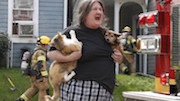 Another surprising thing is that most people would chose to save the life of a dog over a human in some catastrophic situation when they have the choice. Dr. Huber explains it's really interesting if you look at genetic predisposition. What we know is if you have a child, that child is 50-percent your genetics and what the research says is that you would save that child over your dog, while your grandchild is only 25-percent your genes. That seems to be the cutoff and anything less than that and we'd save the dog first!
Another surprising thing is that most people would chose to save the life of a dog over a human in some catastrophic situation when they have the choice. Dr. Huber explains it's really interesting if you look at genetic predisposition. What we know is if you have a child, that child is 50-percent your genetics and what the research says is that you would save that child over your dog, while your grandchild is only 25-percent your genes. That seems to be the cutoff and anything less than that and we'd save the dog first!
Visit Website
The "Do's" and "Don'ts" of Dog Training
Monique Feyrecilde, Licensed Technician
 Monique Feyrecilde breaks the common fallacies associated with training your dog. She'll share the mistakes we make when trying to change our dog's behavior. Monique is next in the spotlight in the Fear Free Pets Expert Series.
Monique Feyrecilde breaks the common fallacies associated with training your dog. She'll share the mistakes we make when trying to change our dog's behavior. Monique is next in the spotlight in the Fear Free Pets Expert Series.
Monique Feyrecilde is a licensed technician and on the Executive Council for Fear Free.
She also does a lot behavior training and has handled many canine behavior cases. Monique tells us how good of a job she thinks most owners do training their dogs. Of course, she thinks that is according to how you measure doing a good job.
Most relationships between families and pets are pretty successful, according to Monique. People like their dog; they enjoy living with their dog; they have a nice relationship with their dog; their dog stays with them for their whole life. She thinks that's probably a training success.
However, if we measure training success as to whether people understand that they're training or not training and if they're getting the behaviors that they want all the time from their animals, then maybe they're a little bit less successful.
 Monique explains that puppy training should start immediately. Learning happens all the time with puppies. Their eyes and ears open around two weeks of age and they're ready to take in lots of new sensory information. The sooner you start training the better. While you might not be training for something complicated like agility or competitive obedience or even service dog tasks until they're a little bit older, you can start teaching them good manners right away. These include things like being social with other animals and people. You can also start teaching them to be accustomed to a variety of different types of handling, like for when they need to go to the vet, when they need to be groomed or when they need to receive a pill. All that training can start right away. Not to mention the house training. Everyone would be disappointed if a puppy wasn't potty trained until six months of age!
Monique explains that puppy training should start immediately. Learning happens all the time with puppies. Their eyes and ears open around two weeks of age and they're ready to take in lots of new sensory information. The sooner you start training the better. While you might not be training for something complicated like agility or competitive obedience or even service dog tasks until they're a little bit older, you can start teaching them good manners right away. These include things like being social with other animals and people. You can also start teaching them to be accustomed to a variety of different types of handling, like for when they need to go to the vet, when they need to be groomed or when they need to receive a pill. All that training can start right away. Not to mention the house training. Everyone would be disappointed if a puppy wasn't potty trained until six months of age!
A big mistake most people make when dog training, according to Monique, is that they fail to acknowledge right behavior and tend to respond to wrong behavior. Unfortunately when their dog is doing the right thing, but it doesn't bother the owner, they tend to ignore their dog. They seem to only respond to their dog or acknowledge them if there's a problem going on.
For instance, if we use the example of being in the kitchen and their dog is getting up on the counter. Generally if their dog is just wandering around the kitchen and doing a great job staying on the floor and keeping "four on the floor," most owners are going to ignore that really good behavior that they really want. They will only respond to their dog when he jumps up and puts his paws on the counter to try and do some counter surfing.
Unfortunately, some dogs might get a little bit of a boost from being reprimanded when they're on the counter. This is because they get touched and talked to and it generates a little bit of excitement. This can unfortunately promote the counter surfing behavior instead of getting rid of it. This is an example of a time where the dog was doing the right thing, but was ignored. The dog then did the wrong thing and got a bunch of attention. This is a missed opportunity to reinforce right behavior that was happening on its own.
 Regrettably, when a dog is behaving properly we don't give them the accolades they deserve and they don't get that boost. But, when they counter surf, we get all excited and they get the attention they are looking for, even if it is negative attention.
Regrettably, when a dog is behaving properly we don't give them the accolades they deserve and they don't get that boost. But, when they counter surf, we get all excited and they get the attention they are looking for, even if it is negative attention.
Another example is jumping. If we come home and our dog is staying on the floor and we get the happy wag, we ignore them until they jump up on us. Then we start saying, "Hey, what are you doing? Get off me!" Well, they got us to stop ignoring them and it was really effective. They got us to look at them, touch them and talk to them and even though we might have in our head, "Oh, I'm scolding the puppy for jumping on me!" We ignored the right behavior and we acknowledged the one that we didn't want. Monique thinks that's a really common mistake.
One tip Monique gives us is that training should be part of your everyday interaction and part of your relationship with your dog. It shouldn't be something you set aside on the calendar and hope that you get to those five, ten or fifteen minutes during the day. We're all so busy it's not going to happen. It's hard enough for people to get their kids to brush their teeth. It's asking a lot to set aside fifteen minutes to train a dog every day. So make training a part of what you're already doing. You're already feeding your dog, make your meal time a training session. You're already playing toy games with your dog, so make your toy games part of a training session. Take advantage. Leverage the time you're already spending building your relationship with your dog and build in some training exercises during those times.
Monique also tells people to try and identify 50 to 100 right decisions that your dog makes every day. Watch your dog when he's going around the house, and if he doesn't jump on the counter, give him a treat. If he doesn't jump on you, give him a treat. If he is staying on the floor or on his bed and holding still, which is amazing, they get a treat for that. Recognize the activities of daily life that you need your dog to do and acknowledge and reinforce them when they happen in the situation.
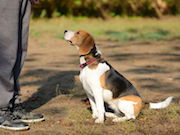 On the other hand, we're doing lots of things right and we have lots of lots of happy people living with lots of happy dogs. One thing Monique feels a lot of people are doing right, that they maybe didn't use to do, is they're reaching out and asking for help when they need it. Help is so available. We're in the technology age. People can get on Facebook or they can get on social media. They can even watch videos. They can do all this kind of stuff and it's easier to reach out to a trainer than it ever has been before. Everybody has a website. Everybody is on social media. It's easy to get ahold of people. She feels that one thing people are doing right is asking for help when they feel like they need it and recognizing that help is available.
On the other hand, we're doing lots of things right and we have lots of lots of happy people living with lots of happy dogs. One thing Monique feels a lot of people are doing right, that they maybe didn't use to do, is they're reaching out and asking for help when they need it. Help is so available. We're in the technology age. People can get on Facebook or they can get on social media. They can even watch videos. They can do all this kind of stuff and it's easier to reach out to a trainer than it ever has been before. Everybody has a website. Everybody is on social media. It's easy to get ahold of people. She feels that one thing people are doing right is asking for help when they feel like they need it and recognizing that help is available.
Monique states it can be sometimes difficult for owners to differentiate good versus potentially harmful methods when they're seeking help, but she thinks reaching out for help is something that dog owners are really doing a better job than they did in the past.
Visit Fear Free Happy Homes for tips on making your home fear free and to locate a Fear Free Veterinarian near you. Go to Fear Free Pets to become certified.
Listen and Explore the Fear Free Expert Series
Homeless Pets Need More Vets
Genevieve Frederick, Pets of the Homeless
 Genevieve Frederick heads up an organization that connects pet food and veterinary care with homeless folks and their animals. Since 2008, her non-profit has found health care for 17,500 pets. Now, the organization is on the hunt for more veterinary practitioners to offer discounted assistance to the homeless.
Genevieve Frederick heads up an organization that connects pet food and veterinary care with homeless folks and their animals. Since 2008, her non-profit has found health care for 17,500 pets. Now, the organization is on the hunt for more veterinary practitioners to offer discounted assistance to the homeless.
Genevieve Frederick is the founder of Pets of the Homeless. Pets of the Homeless has four unique programs, but their mission statement is that they believe in the healing power of companion pets and the human animal bond. This is because homeless people find solace, protection and companionship through their pets. They also care for their pets on limited resources so they themselves have less. The national take of Pets of The Homeless is to feed and provide basic emergency veterinary care to those pets and thus relieve the anguish and the anxiety of the homeless who cannot provide for their pets.
Surprisingly, many people feel that homeless people shouldn't even own a pet. But when you think about it, this might be the only thing they have. It gives them something to live for. For a woman it could be protection. The animals give the homeless unconditional love, something that they can't get anywhere else. On the other hand, these animals are actually kind of lucky, because they're with their owners most of the time. These animals don't sit at home alone from 9 to 5 waiting for their owner to come home who is then too tired to give them any attention.
Genevieve feels if we can turn these people around, then they'll have more compassion and empathy for what's going on. Homelessness is not decreasing by any means, because there is not enough low-income housing across America. It's forcing more and more people to live on the edge.
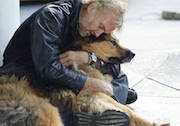 In 2017, Pets of the Homeless assisted 768 homeless people who did not have the resources to take their pet to a hospital at a cost exceeding $176,800. The average cost for a veterinary visit was $232. Participating veterinary offices showed their commitment by discounting over $44,000 in service fees in 2017.
In 2017, Pets of the Homeless assisted 768 homeless people who did not have the resources to take their pet to a hospital at a cost exceeding $176,800. The average cost for a veterinary visit was $232. Participating veterinary offices showed their commitment by discounting over $44,000 in service fees in 2017.
Pets of the Homeless is now looking to expand its national network of veterinarians to provide emergency veterinary care.
The local participating veterinarian must agree to do an exam and treatment(s) at a minimum 20-percent discount. The veterinary hospital/clinic is required to call, email or fax Pets of the Homeless an estimate for treatment after the initial exam. Program services are limited to: acute injury or illness, updating vaccinations during procedures, spay/neuter if authorized during procedures and euthanasia. Pets of the Homeless makes every effort to assist every pet as they are presented.
The emergency veterinary care process is as follows:
- The homeless person must pre-register for treatment with a Pets of the Homeless employee case manager.
- The Pets of the Homeless case manager contacts the veterinary hospital/clinic to pre-authorize the initial exam.
- After the initial exam, the veterinary hospital/clinic submits a treatment plan to Pets of the Homeless for approval. Which then an approval code is given.
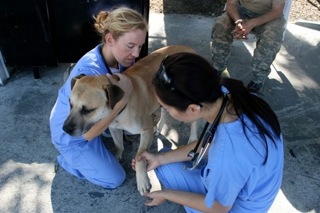 - A Pets of the Homeless employee case manager reviews the treatment plan and any additional treatment.
- A Pets of the Homeless employee case manager reviews the treatment plan and any additional treatment.
- Pets of the Homeless is not responsible for any veterinary bill if prior approval is not secured by staff.
- Pets of the Homeless pays hospitals direct at time of service.
- Our Pets of the Homeless employee case managers are available between the hours of 9:00 a.m. - 3:00 p.m. (PST) Monday - Friday. Messages are returned the next business day.
- Pets of the Homeless uses the following criteria to determine homelessness: living in a transitional or emergency shelter, living in a campground, tent or vehicle, living in inadequate housing that lacks electricity, plumbing and heating or living in a motel (short-term 1-2 weeks at a time).
- Due to funding limitations, Pets of the Homeless programs do not include coverage of: dental cleaning, cremation services, non-core vaccinations, grooming, unnecessary lab work or x-rays, ongoing treatment, ongoing medications, boarding, pets with a diagnosis of cancer or diabetes and breeds (dogs and cats) over 14 years old.
Emergency care is the most costly program due to the type of veterinary services needed to treat pets. Frequent diagnosis includes parvovirus, swallowed foreign objects, skin lesions, injured limbs, ear infections, lacerations and digestive issues. Treatment is costly because it often includes x-rays, lab tests, sutures, surgery and overnight stays.
Genevieve explains that participating veterinarians do get paid. They are just asked to give a 20 to 25-percent discount. Please talk to your own veterinarian and tell them about the program and ask them to contact Pets of the Homeless to participate.
Visit Website
Black Widow Spiders Poisonous to Pets -Dr. Debbie
 Pet Threats Come in All Sizes
Pet Threats Come in All Sizes
Our doggie family ambled along on our typical morning walk along the community trail. With a family of two Labradors and a Yorkie mix, my crew is always up for fun and they investigate anything and everything.
Sometimes it's a crunchy cockroach snack or the fortunate edible remnant in a discarded candy wrapper. My dogs enjoy the "date game" where they snatch up shriveled fruit fallen from date palms, crunching away before the mom and dad notice. And sometimes it's a half-hearted game of chase with an unsuspecting rabbit. A more gut wrenching episode once involved my Labrador ingesting a rat with tail slipping down his gullet like a piece of spaghetti. My furry kids are professional trouble finders so I try to keep a watchful eye for things that make them go "Oooh," and make me go "Ugh!"
Female Black Widow Spider
While walking along the pedestrian pathway we came upon today's discovery - spiders and lots of them living in the recesses of a block wall. The hairs on my arm stood up as my Yorkie mix approached their lair. I recognize what these spiders are and what could happen to a 16-pound pup.
The long legged spiders were over 1 1/2" in length, black in color with a distinctive orange hourglass mark on its underbelly. Meet the black widow spider, a common arachnid found in every state in the U.S. except Alaska.
The Black Widow Bite
Black widow spiders contain a potent neurotoxin that causes pain, swelling and can lead paralysis. Female black widows are the dangerous ones, while the males rarely ever bite. While some black widow bites go unnoticed, others cause immediate pain at the site or result in pain at the nearest lymph node. Pain intensity reaches its maximum within 1 to 3 hours after the bite, but can last up to 48 hours.
Symptoms of a black widow bite appear within 8 hours after bite an include muscle twitching, restlessness, rigid abdomen and difficulty breathing. Symptoms may result in high blood pressure, a racing heart rate, seizures and collapse. Dogs are more resistant to a black widow bite, but still can suffer serious illness. Cats are very sensitive to the toxins and can suffer fatalities.
Symptoms of black widow bite include:
 - Pain and numbness around bite site
- Pain and numbness around bite site
- Anxiety
- Racing heart rate
- Muscle pain and stiffness, especially abdominal muscles
- Difficulty breathing
- Paralysis
- Seizures
Treatment for Black Widow Spider Bite
Call your veterinarian if you suspect your pet was bitten by a black widow. Initial home emergency care of a black widow bite may include ice packing bite area and oral antihistamines like Benadryl. Your veterinarian will need to see your pet to evaluate and treat the more serious symptoms. Treatment may include medications to control muscle spasms and seizures. Blood pressure and blood sugar are monitored and intravenous fluids may be administered. An antivenin is available for more serious confirmed cases of black widow bite.
Prevention
Avoidance of spider habitats is the best prevention. These eight-legged critters favor dark recesses both indoors and outdoors. Look for cobwebs with a distinctive funnel-shaped opening at the top. And keep a close eye on your dog when out exploring. Inquire about spider control methods with your pest control company.
With pet noses so close to web level, the risk of black widow bites is just natural to being a dog. Our morning spider encounter ended without any drama, thankfully. After one firm "No," my doggies retreated to unearth some other lucky find. Here's to hoping it doesn't involve any rats or bugs next time.
Featured veterinarian known as "Dr. Debbie" on national pet radio program, Animal Radio. Ebook author of "Yorkshire Terriers: How to Be Your Dog's Best Friend"; "Pugs: How to Be Your Dog's Best Friend"; "Mini Schnauzers: How to Be Your Dog's Best Friend"; and "Shih Tzu: How to Be Your Dog's Best Friend." Dr. Debbie's books.
Visit Website
5 Ways To Up Your Pet Parenting Game During National Responsible Pet Owners Month
Robert Semrow, Listomania
 Taking on the lifelong commitment to care for a pet is more than an act of love, it's a promise of responsible actions for another living being. Since we can all step our game, here are 5 ways you can step up your Responsible Pet Ownership efforts:
Taking on the lifelong commitment to care for a pet is more than an act of love, it's a promise of responsible actions for another living being. Since we can all step our game, here are 5 ways you can step up your Responsible Pet Ownership efforts:
Let's start with something that isn't just being responsible, it's being smart. Be proactive by going around your house and pet proofing your home. When is the last time that you did that? Probably when you just adopted them in to your home. Whether that was last week or many years ago, your home has changed. Take a pet's eye view of your home now and see what temptations and dangers can be avoided. It may not only save your pet's life, it may save your pocketbook as well.
Next, take some time to research what your pets nutritional needs are. I was recently at a pet event and I was somewhat surprised to hear the answers to a question I posed to different pet owners, "What are your pets nutritional needs for your type of pet to thrive?" If you don't know, that's ok, but be responsible and seek out a pet nutritionist or expert and find out what your pet really needs. It will benefit both you and your pet to know what their nutritional needs really are.
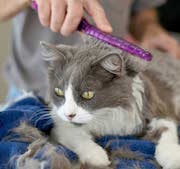 Responsible health care habits is another area that many of us can step up our responsible pet parenting activities. This can range from regular grooming, to exercise, to an annual vet check-up. As a responsible pet parent we should be in contact with and/or observing our pets in close proximity for any changes in their health, both physical and mental. You are their pet health manager and you will need to make the call on which team member you need assistance for to care for your pet.
Responsible health care habits is another area that many of us can step up our responsible pet parenting activities. This can range from regular grooming, to exercise, to an annual vet check-up. As a responsible pet parent we should be in contact with and/or observing our pets in close proximity for any changes in their health, both physical and mental. You are their pet health manager and you will need to make the call on which team member you need assistance for to care for your pet.
Another way to up your game is to learn something new with your pet. Whether it's an activity or way to give extra at home care, find something that you and your pet can embark on to improve their lives and enhance your pet parenting experience.
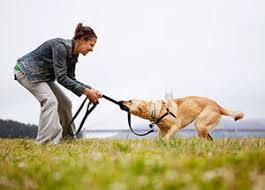 This last one is the easiest, but the one most often sacrificed. Responsible pet ownership requires time and prioritization. Just like children, your pets need to be at the top of your prioritization list and you must make the time to not only care for them, but to be a part of their lives. They are resourceful and forgiving, but they all want something that you can't buy or have someone else give them - you, your love and care.
This last one is the easiest, but the one most often sacrificed. Responsible pet ownership requires time and prioritization. Just like children, your pets need to be at the top of your prioritization list and you must make the time to not only care for them, but to be a part of their lives. They are resourceful and forgiving, but they all want something that you can't buy or have someone else give them - you, your love and care.
Share your ideas on how to be the best responsible pet owner on our Animal Radio Facebook Page.
Visit Website
Animal Radio News - Lori Brooks
 Cat Plague Is On The Rise Is Australia
Cat Plague Is On The Rise Is Australia
We know there are pet parents who do not like to vaccinate their pets, but consider this parallel. The deadly cat disease feline panleukopenia, or "cat plague," is on the rise is Australia. This is significant because the sickness hasn't been an issue for cats down under for 40 years thanks to a vaccine developed during the 1970s. But in the last couple of years, cat plague has reemerged. Feline panleukopenia, or FP, is a highly contagious virus that attacks cells that rapidly divide like those found in bone marrow, intestines and developing unborn kittens. If the disease attacks and destroys bone marrow cells, the cats can no longer produce white blood cells, an important part of the immune system. Infected cats then often develop serious secondary infections. The virus can be transmitted through urine, feces or even fleas from other cats. It typically takes two days for an infected cat or kitten to become symptomatic, so the risk of transmission is extremely high.
 You Can Teach Older Dogs New (Computer) Tricks
You Can Teach Older Dogs New (Computer) Tricks
Researchers from the University of Veterinary Medicine in Vienna have found that older dogs benefit from playing computer games using a touch screen. Their new research shows it might stave off cognitive decline. The scientists found that brain training and problem solving can slow the pace of brain deterioration. However, the older dogs that could benefit from the training are rarely introduced to it. As we know, unlike puppies or young dogs, older dogs are almost never trained or challenged mentally, because senior dogs are usually perfectly integrated into our lives and we just forgive them for any disobedience or stubbornness. According to the new study, computer games paired with a reward system can replace demanding physical training and increase dogs' brainpower. This process was tested during the study in a laboratory and researchers say the next step is converting it to a living room-friendly format. The study compared computer games for elderly dogs to elderly humans doing Sudoku puzzles. The study says that as the dogs get older, we increasingly and unconsciously reduce the level of regular training. But the authors of the study emphasized that this isn't a favor to older dogs, because it restricts the opportunities to create positive mental experiences for dogs, which remain capable of learning even in old age. To be totally honest here, the researchers who worked on the study admitted that it was challenging to get dogs acclimated to using touch screens. But they say once the animals learned how to do it; they turn into avid computer gamers. And, some dogs are quicker to learn than others. Dogs that were bred to hunt, retrieve or herd are faster learners. Similarly, dogs bred to guard livestock or track scents are usually slower. Just remember if you try this, rewarding dogs when they take part in touch screen training is of the utmost importance. Experts say above all, the prospect of a reward is an important factor to motivate the animals to do something new or challenging. Regular brain training sorts dogs out of their apathy in old age, increasing motivation and engagement and thus maximizing learning opportunities.
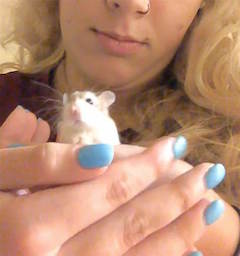 Airline Passenger Told To Flush Hamster Down Toilet
Airline Passenger Told To Flush Hamster Down Toilet
This story has become the latest controversial case in airlines versus people seeking to travel with emotional support animals. It all began last Thanksgiving weekend when a beloved pet hamster was flushed down a toilet in an airport bathroom, supposedly after the airline, Spirit Airlines, refused to let a 21-year-old college student bring her pet hamster, Pebbles, on a flight as an emotional support animal. The woman's attorney accuses the airline of causing his client to tearfully flush Pebbles the hamster down a toilet after being denied a seat on the flight with the hamster. The woman says an airline employ suggested she flush the hamster, but the airline denies the accusation. As goes a lot of similar stories, the student says she was told over the phone by an airline employee that she could fly with Pebbles as an emotional support animal, but then would not let her on the flight with her hamster once she got to the airport. The young woman was a college student in Pennsylvania but was withdrawing from school due to a medical issue. She was flying from Baltimore where the incident happened, home to her parents in Florida. The airline says, "After researching this incident, we can say confidently that at no point did any of our agents suggest this guest (or any other for that matter) should flush or otherwise injure an animal." However, Spirit's spokesman did acknowledge that a reservation agent unfortunately, did misinform the guest that a hamster was permitted to fly as an emotional support animal on Spirit Airlines. In conjunction with the Federal Department of Transportation's guidelines, their website clearly states that it "does not accept snakes, other reptiles, rodents, ferrets and spiders," and that unusual animals or pets are to be evaluated on a case-by-case basis.
 Most Expensive Pet Food
Most Expensive Pet Food
Most people are looking for ways that nutrition can solve their dogs' health problems, like allergies. While searching the Internet, you might even click on pop up dog food ads. If you do, you might have seen an ad for a dog food called Carna4, which at first looked like it cost $15 for a 12-pound bag. The food contains vitamins, minerals, enzymes and probiotics. It contains real meat with no meat meals or rendered fats. It is also safe, as every batch of Carna4 is quarantined for 2 weeks while they test for 15 pathogens and toxins including salmonella, E. coli, toxins and mercury. The reviews are excellent and it had 4 ½ out of 5 stars on Amazon. However, when you look closely, what may have first appeared to look like $15 dollars for 12-pounds, is really $115. This just might be the most expensive packaged dog food ever.
 Listen to the entire Podcast of this show (#951)
Listen to the entire Podcast of this show (#951)





